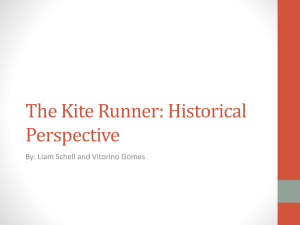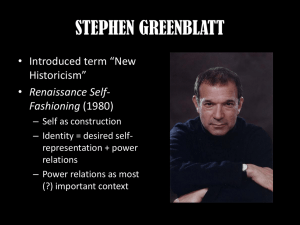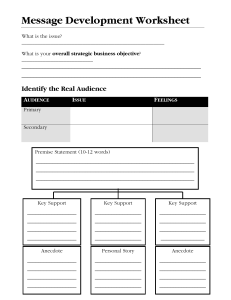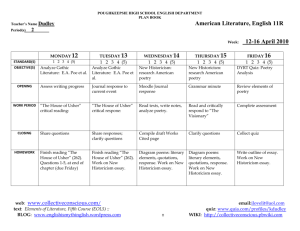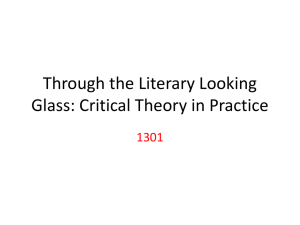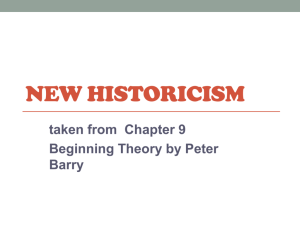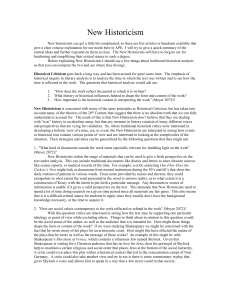Reviews
advertisement
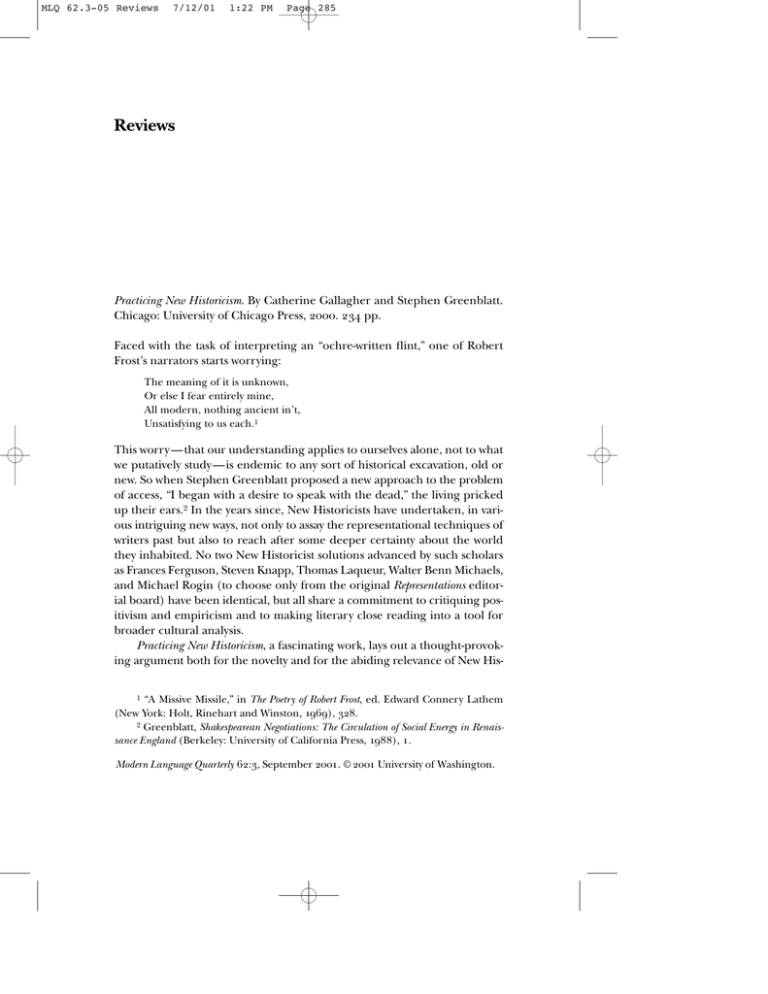
MLQ 62.3-05 Reviews 7/12/01 1:22 PM Page 285 Reviews Practicing New Historicism. By Catherine Gallagher and Stephen Greenblatt. Chicago: University of Chicago Press, 2000. 234 pp. Faced with the task of interpreting an “ochre-written flint,” one of Robert Frost’s narrators starts worrying: The meaning of it is unknown, Or else I fear entirely mine, All modern, nothing ancient in’t, Unsatisfying to us each.1 This worry — that our understanding applies to ourselves alone, not to what we putatively study — is endemic to any sort of historical excavation, old or new. So when Stephen Greenblatt proposed a new approach to the problem of access, “I began with a desire to speak with the dead,” the living pricked up their ears.2 In the years since, New Historicists have undertaken, in various intriguing new ways, not only to assay the representational techniques of writers past but also to reach after some deeper certainty about the world they inhabited. No two New Historicist solutions advanced by such scholars as Frances Ferguson, Steven Knapp, Thomas Laqueur, Walter Benn Michaels, and Michael Rogin (to choose only from the original Representations editorial board) have been identical, but all share a commitment to critiquing positivism and empiricism and to making literary close reading into a tool for broader cultural analysis. Practicing New Historicism, a fascinating work, lays out a thought-provoking argument both for the novelty and for the abiding relevance of New His1 “A Missive Missile,” in The Poetry of Robert Frost, ed. Edward Connery Lathem (New York: Holt, Rinehart and Winston, 1969), 328. 2 Greenblatt, Shakespearean Negotiations: The Circulation of Social Energy in Renaissance England (Berkeley: University of California Press, 1988), 1. Modern Language Quarterly 62:3, September 2001. © 2001 University of Washington. MLQ 62.3-05 Reviews 286 7/12/01 1:22 PM Page 286 MLQ ❙ September 2001 toricism. The book is manifestly composed by two very different hands: two eighteenth- and nineteenth-century chapters and a theoretical one are by Gallagher; two Renaissance chapters and another theoretical one are by Greenblatt; the authors then “transform[ed] the first-person singular into the first-person plural” (18) throughout. However, those reading a New Historicist work for the first time will find the central claims, debates, and methodology lucidly expostulated in the introduction and two theoretical chapters (“The Touch of the Real” and “Counterhistory and the Anecdote”). Those already impressed by Gallagher and Greenblatt will find plenty of reasons to continue to admire and learn from them. Those who have quarrels with the methods of New Historicism — especially its willingness to make close readings of tiny cultural moments broaden out into wideranging claims about an epoch’s thoughts and even its emotional register — are unlikely to be converted, but they too will find some strong new arguments here. In the book’s exposition of New Historicism’s core practices, intriguing tensions emerge. First, Gallagher and Greenblatt deny — predictably, but more explicitly and strenuously than might have been expected — that what they do constitutes a theoretical program. Citing their “commitment to particularity,” they aspire to “route their theoretical and methodological generalizations through dense networks of particulars” and claim that “writing this book has convinced us that new historicism is not a repeatable methodology or a literary critical program” (19). Because they do not want “to see the long chains of close analysis go up in a puff of abstraction,” they express the hope that “you will not be able to say what it all adds up to; if you could, we would have failed” (19). That conditional contrary to fact is witty, but it is not just the reviewer’s perennial desire to find a generalizable claim that makes me leery of that refusal to add up. There is a contradiction here: the most resolutely particularized piece of close reading enacts a methodology. Subtract abstraction and everything goes up in a puff. What can the “touch of the real” that Gallagher and Greenblatt call for be, if that real is not made comprehensible by the methodology they propose? There is, especially in “The Touch of the Real,” a meditation on the aftereffects of Erich Auerbach’s seminal Mimesis, a lingering trace of the desire Frost warns against — that the real as-it-was may make itself manifest to the scholar: “We wanted to find in the past real bodies and living voices, and if we knew that we could not find these — the bodies having long moldered away and the voices fallen silent —we could at least seize upon those traces that seemed to be close to actual experience” (30). But what grounds such claims of closeness? Frost was right to worry that those who claim too close a proximity to their material often end up telling stories of their own lives and minds, not of those they set out to map. New Historicists MLQ 62.3-05 Reviews 7/12/01 Plotz ❙ Review 1:22 PM Page 287 287 may hope to follow a Geertzian path in “making the literary and the nonliterary seem to be each other’s thick description” (31), but how ought the reader read the word seem ? For seeming (like Gallagher and Greenblatt’s matching claim that certain traces “seemed to be close to actual experience”) is the stuff of representation, for better or worse. What high road to the actual could such seeming claim? Indeed, as the book’s four evidentiary chapters powerfully remind us, there can be no knowledge about the actuality of the past that is not filtered through our investigations of representational practices in another time and at another place. Chapter 4, “The Potato in the Materialist Imagination,” for example, reads the history of elementary foodstuffs in England as the key to parsing the rules that structure eighteenth- and nineteenth-century representational practices. While chapter 5, “The Mousetrap,” argues that communion wafers seemed to Reformation theologians “a conspiracy . . . to transform trope into flesh” (146), making the divine improperly appear present in “a private churlish breakfast” (141), chapter 4 suggests conversely that the potato comes to signify not an entirely divine but an utterly earthly aliment. The two cases are strikingly congruent because even the real-belowbread potato is parsable only as part of a system of representation, where, like the communion wafer, it poses a limit problem. “The Potato” thus proposes a crucial revision to a seminal work in British cultural materialism, E. P. Thompson’s 1971 “Moral Economy of the Crowd.”3 Gallagher and Greenblatt rightly fault Thompson for depending on “an unvarying physical substratum” (124), by which bread is the basic foodstuff: for Thompson to acknowledge that below bread lay potato would be to contaminate his model. “Thompson’s resistance to the potato is symptomatic of cultural materialism’s desire for a moral economy of explanation that assumes the reasonableness of popular action and its conformity to an implied human norm” (124). New Historicism of the sort that Gallagher and Greenblatt propose aims to show that the illusion of “an unvarying physical substratum” relies on a particular era’s (and nation’s) representational rules: indeed, the very idea of the norm is a nineteenth-century development. Brilliant readings like this one, however, stand in an odd relation to the introduction’s faith in the “seeming” reality of certain kinds of traces. If potato and communion wafer mark a “linguistic turn” even at the edges of signification, what grounds the pesky claim (or perhaps it is only a wish) to touch the actual? What grounds that admitted desire to speak neither of nor to but with the dead? Practicing New Historicism makes its most interesting turn here, arguing 3 This essay is reprinted, along with “The Moral Economy Reviewed,” in Thompson, Customs in Common (New York: New, 1991), 185 – 258. MLQ 62.3-05 Reviews 288 7/12/01 1:22 PM Page 288 MLQ ❙ September 2001 its way out of the corner by claiming that two sorts of data — anecdotes and bodies — can render a vivid sort of presence that other sorts of data cannot supply. Only in reading this book did I recognize how closely anecdotes and bodies have always been allied in New Historicist methodology. The “claim on the truth that is denied to the most eloquent of literary texts” (48), after all, lies in the details that remain undigested, and whose very resistance to interpretation becomes interpretable. Anecdote and body are both reduced fragments of a larger whole, yet fragments that defy simply being made representative of the larger mass. Rather than resembling a fractal, which in every microcosm repeats the macrocosmic structure, each anecdote or body seems to Gallagher and Greenblatt to reveal things about the general by virtue of the very features (its novelty, its seeming irreproducibility) that would exactly seem to discredit it as an exemplum. They are in a sense exemplary in their anti-exemplarity.4 Gallagher and Greenblatt fear the violence done to both anecdote and body when they are blown up to society size to prove a larger point. They cite Roland Barthes’s work on “notation” as the thing that defies the discourse of history, and (crediting Joel Fineman with the leap) they explain that New Historicists “sought the very thing that made anecdotes ciphers to many historians: a vehement and cryptic particularity” (51). The crucial word here is vehement, which attributes agency, indeed something akin to subjectivity, to these texts. Just as anecdotes (or mementos like Cardinal Wolsey’s hat) have served New Historicists as ways to unsettle the relationship between representations and the real, so bodies are mobilized in Practicing New Historicism as something that ruptures certainties of narrative: “In the larger perspective of the cultural text, representations similarly ceased to have a settled relationship of symbolic distance from matter and particularly from human bodies” (15). There is, however, a problem. Anecdotes cannot be definitively disjoined from the texts in which they appear: What makes an anecdote? Who says so? 4 See Joel Fineman, “The History of the Anecdote: Fiction and Fiction,” in The New Historicism, ed. H. Aram Veeser (New York: Routledge, 1989), 49 –77, which Gallagher and Greenblatt discuss, for a memorable New Historicist theorization of the anecdote; one striking analysis of the body’s role in New Historicism is Thomas Laqueur, “Bodies, Details, and the Humanitarian Narrative,” in The New Cultural History, ed. Lynn Hunt (Berkeley: University of California Press, 1989), 176 – 204. Two articles by Alan Liu also analyze the New Historicist attachment to anecdotes: “The Power of Formalism: The New Historicism,” ELH 56 (1989): 721–71; and “Local Transcendence: Cultural Criticism, Postmodernism, and the Romanticism of Detail,” Representations 32 (1990): 75 –113. James Chandler, England in 1819: The Politics of Literary Culture and the Case of Romantic Historicism (Chicago: University of Chicago Press, 1998), is a compelling exploration of the logic of the case and the exemplum, both of which can be read as offering evidentiary alternatives to the anecdote. MLQ 62.3-05 Reviews 7/12/01 Plotz ❙ Review 1:22 PM Page 289 289 Are there any formal rules for defining it apart from what Walter Benjamin offered: “that chaste compactness of an anecdote that precludes psychological analysis”?5 By the same token (as the potato chapter convincingly argues), bodies — despite their unique status as home base for any individual, the place from which all thought proceeds and to which it returns — do not “mean” apart from the system of matter and representation in which they circulate. Despite its strong claims for the completeness of discourse, Practicing New Historicism is not quite ready to give up on bodily anomaly: “Perhaps paradoxically, though, they [body historians, we among them] also tend to privilege the body as a place where culture has a peculiarly tenacious hold” (126). Bodies are to be “privileged” just as anecdotes are, and tenacious (like vehement) means that there is a truth available in bodies distinct from what is generally available elsewhere. A striking programmatic claim in the introduction clarifies this: “The way[s] bodies were understood to function . . . were all closely bound up with particular cultural representations, but they could not simply be reduced to these representations. The body functions as a kind of ‘spoiler,’ always baffling or exceeding the ways in which it is represented” (15). In other words, if the potato chapter calls for a culturalism that goes farther into bodies, the introduction apparently asks for a bodyism that goes farther into culture. This may seem simply a tension that bespeaks rifts in the collaboration between Gallagher and Greenblatt. But I think that the paradox runs deeper. Both the anecdote and the body “seem” to bear “the touch of the real” because they share a vehement particularity that, in its very failure to reproduce larger structures, reveals those stuctures. Both bodies and anecdotes thus offer New Historicists a way into particularity—but a way that cannot help leading back to exemplarity. They cannot dispense with judgment, understood in the Kantian fashion as the linkage of an image and a concept. In returning in this way to judgment, however, New Historicists are not simply defeated in their attempt to reconsider the nature of particularity. Something is decidedly gained. Do New Historicism’s theorists appear reluctant to admit that the reconciliation of the fragment of the past and a coherent picture of that past can take place by way of an imagination that brings particular and general together? If so, their insistence on sharply separating the two from one another is at least a crucial step on the road toward explaining how the anecdote or the single body explains something about the social whole that an account of the social whole, constituted only on the level of the general, cannot reveal. 5 Benjamin, “The Storyteller: Reflections on the Works of Nicholai Leskov,” in Illuminations, ed. Hannah Arendt, trans. Harry Zohn (New York: Schocken, 1969), 91. MLQ 62.3-05 Reviews 7/12/01 1:22 PM Page 290 MLQ ❙ September 2001 290 Peculiar it may sound, but it is nonetheless true that extracting general significance from a particularity may depend on at least a first-order deferral of the rush to exemplarity. Read Luther’s famous refusal proleptically, as Protestantism’s defining moment, and you risk losing the sense of it as a moment in which Protestantism had no being other than in the isolated gesture itself. Or consider the excessive attachment to historical sequence built into Georg Lukács’s famous praise of Walter Scott, who “represents simultaneously the historical necessity of this particular individual personality and the individual role he plays in history.”6 Lukács’s seeming opposition here actually collapses into the single claim that to be an individual is to play a historical role. But if Lukács discerns a deeper historical spirit animating each free actor, Scott’s novels demonstrate that the historical sequence can emerge only out of “the individual role” that a character “plays in history.” Lukács fails to do justice to Scott’s own conception of the nongeneralizable individual identity out of which the exemplary instances of “history” eventually crystallize. It is individuals who are general history, and, despite what Lukács argues, we see history not through them but in them. The New Historicist case for “vehement particularity” is a new and compelling way of understanding this necessary attention to the local, in its abiding locality, whenever claims about the general are made. John Plotz, Johns Hopkins University The Full-Knowing Reader: Allusion and the Power of the Reader in the Western Literary Tradition. By Joseph Pucci. New Haven, Conn.: Yale University Press, 1998. xxii + 263 pp. Critical discussion of the phenomenon of allusion (in the sense of a brief, identifiable verbal reminiscence of an earlier literary work in a later one) is beset by terminological difficulties. In one respect, there is a superabundance of terminology, since newer terms, such as intertextuality or anxiety of influence, which might seem to be helpful, in fact have little to do with allusion. In another respect, there is a terminological dearth; it confuses discussions of the phenomenon, for example, that there is not one term for the allusive phrase as it appears in the alluding text and another, distinct term for that phrase as it appears in the anterior text. One strength of Joseph Pucci’s book The Full-Knowing Reader is that it introduces into the study of allusion greater terminological and conceptual 6 Lukács, The Historical Novel, trans. Hannah Mitchell and Stanley Mitchell (London: Merlin, 1962), 50. Modern Language Quarterly 62:3, September 2001. © 2001 University of Washington.
